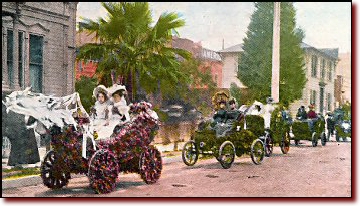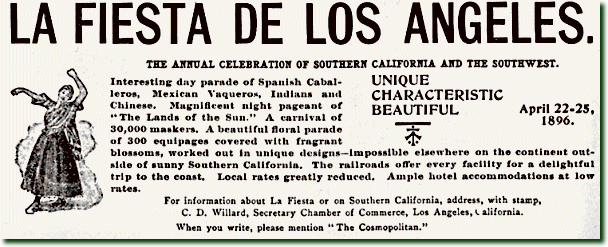
Procession of motorized floats is depicted in scene from early staging of "La Fiesta de Los Angeles"
Wednesday, March 21, 2007
Page 15
REMINISCING (Column)
‘La Fiesta’ Is Annual Event in Late Victorian L.A.
By ROGER M. GRACE
|
|
Procession of motorized floats is depicted in scene from early staging of "La Fiesta de Los Angeles" |
|
“La Fiesta de Los Angeles” was a week-long party that the city threw in its own honor during the 1890s. Staged by the Merchants’ Assn., it featured parades—a flower parade, aparade with floats, a torchlight procession—and athletic competitions, a costume ball, and a carnival attended by masked revelers.
The Spanish title was reflective of a goal: to capture the color and the aura of old Los Angeles in its days as a pueblo under Mexican rule. Men in the garb of caballeros (horsemen) and vaqueros (cow hands) participated.
So did Chinese, native Americans, and African Americans. It was a multi-cultural gala, distinct from any celebration elsewhere.
The first fiesta was held in April, 1894. So successful was it that one of the organizers, a dry goods merchant with a shop on Spring Street named J.T. Shewart, beamed in an advertisement in the Times:
“Everyone is of one opinion about the fiesta. It was an unqualified success in every particular....The Merchants’ Association was not organized for personal gain. They had but one object in view, and that was to give an entertainment of the highest order which would reflect credit upon their efforts. The poorest beggar on the streets had the same opportunity to enjoy the festivities as a millionaire....Mr. [Hans] Jevne, Mr. T.A. Gardner [manager of an ice cream, candy, and lunch parlor business] and Mr. Sheward are the members of the Finance Committee, and all bills that have been audited shows the greatest care in the expenditures on the part of each committee. The policy has been to show how large a carnival can be given for the smallest amount of money. Already the Merchants’ Association has started in for next year’s Fiesta....Next year’s La Fiesta will exceed anything of the kind ever attempted in America.”
In 1931, the man who came up with the idea for the event and was director-general of it the first two years, wrote an article for the Times on his recollections. As to the 1895 staging, Max Meyberg says:
“Against my protest, I was compelled to take charge of the 1895 fiesta. The finance committee, Mr. [M.H.] Newmark, Mr. [J.O.] Koepfli and Mr. Jevne, concluded that it would require $30,000 to finance it.
“We constructed and made out of what is now Pershing Square a coliseum, encircling the park with seats ten tiers high. All of our parades circled around this park, which was beautifully decorated with flags and banners with a throne in the park for the queen and her court, reviewing the parades. The feature which created the greatest interest was the battle of flowers—a scene of beauty and charm.
“Every day we had parades and in the evening lighted floats bearing young ladies. A masquerade ball and concerts closed the festival of 1895. It cost $32,500, with a $2000 deficit and $7000 in assets.”
The 1896 fiesta was sponsored by the Chamber of Commerce and the Board of Trade, as well as the Merchants’ Assn. At Jevne’s suggestion, it was run by a “Committee of 30” (10 men from each organization). Jevne was the treasurer.
William Deverell says in his 2004 book, “Whitewashed Adobe: The Rise of Los Angeles and the Remaking of Its Mexican Past”:
“The main parade event of 1896, which took place on April 22, was more elaborate than any in previous Fiestas. A giant banner—‘VIVA LA FIESTA 1896’—hung across the main parade route. Three hundred United States Marines, anchored just off the coast aboard the man-of-war Philadelphia, marched alongside members of the California National Guard, the Spanish caballeros, and squadrons of local police. Fifty Native Americans, brought in from the California desert around Temecula, marched in native dress (described by one local paper as ‘one hundred Yuma Indians with G strings and paint’). The Chinese dragon, transported all the way from Marysville in the gold country, made its appearance, carried on the shoulders of ‘150 Celestials.’ The whole affair was graced by the music of the ‘La Fiesta March.’ ”
Here's an ad for the fiesta that appeared in a national magazine:

Copyright 2007, Metropolitan News Company